 By Pepper Parr
By Pepper Parr
July 23rd, 2019
BURLINGTON, ON
This is a seven part series on transit and how Burlington plans to get to the point where the public will take public transit to get to where they want to go in the city because it is cheaper, faster, more convenient and seen as the smart thing to do.
The world of municipalities is all about planning; trying to determine today what will have to be in place in two years, five years, perhaps as much as a decade away.
While the bureaucrats plan – the ground underneath them shifts.
Burlington is being pulled – kicking and screaming – into a world where they are not going to be able to get around all that well if they rely on their cars – the roads will be plugged – grid lock will be come as relevant as climate change.
Get used to using public transit.
The city is going to have to get itself to the point where it can offer public transit that people will want to take because it is convenient, reliable, reasonably priced and not something a large part of the city’s residents turn their nose up at.
But transit is going to have to meet the challenge if people expect to be able to get around the city.
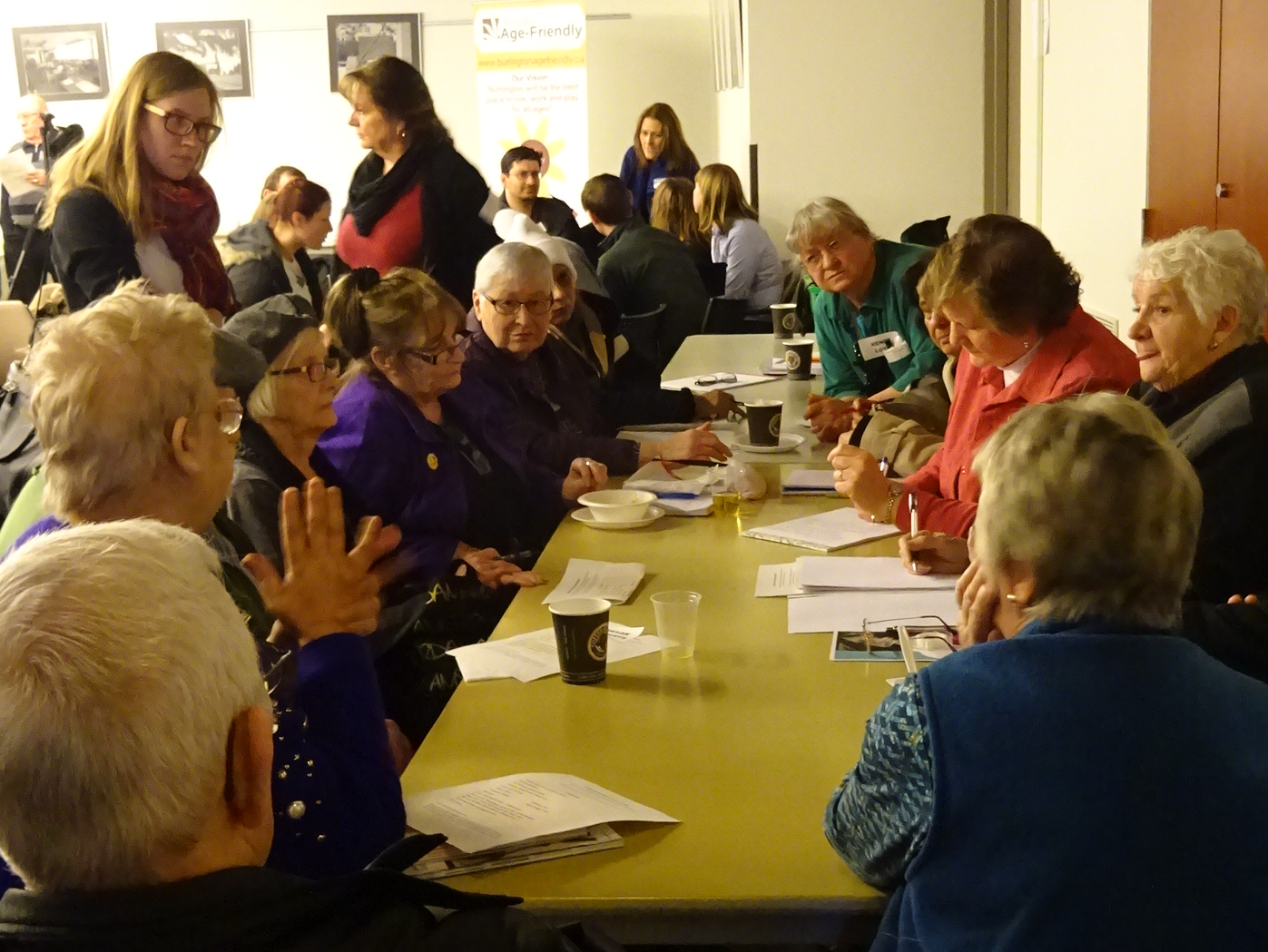
Senior citizens gather at a Bfast meeting to talk about the changes they need in transit.
The 2024 target identified for Burlington represents a significant rate of growth over past
performance and above what Burlington Transit’s peers have achieved over the past five years. This will be difficult to achieve in a short period of time without significant investment in transit, a focus on customer service and culture change, including a change in how transit services are delivered.
A summary of the Transit Five-Year Business Plan peer review, vision and growth plan initiatives was presented to city council recently.
In the past, the quality of the leadership at Transit was a bit of a joke. The planning that was done could only be described as pathetic.
When the city went looking for new transit leadership they got lucky – Sue Connor who earned a stellar reputation for the changes she made at the Brampton Transit operation took the job offer Burlington made.

Transit Director Sue Connor
Ms Connor had to fight for every dollar the 2014-18 city council grudgingly gave her – but she persevered and prevailed.
Now she has gotten her teeth into what has to be done in Burlington to meet the change that is coming our way.
The Business Plan document will be based on data collected with a focus on the implementation of the growth plan initiatives, including their phasing and financial impacts.
Dillon Consulting, the people who did the background work has asked that Burlington Council provide feedback on these sections, so that any changes may be incorporated into the final Business Plan.
The 2020 – 2024 Burlington Transit Business Plan will guide the implementation of transit service improvements over the next five years. The Business Plan starts with a policy framework that defines a clear direction for Burlington Transit, and clear steps on how to get there.
It is important to note that a Business Plan does not provide details of service or operational planning. The primary purpose of the plan is to ensure individual strategies, projects and activities are aligned and
contributing to the Burlington Transit’s vision and policy objectives. This includes prioritizing and staging key decisions to fit within the City’s financial guidelines.
The Business Plan is also an important communication tool for Burlington Transit that will clearly set out steps required to move towards the long-term direction of the City. Over the next five-years, the Business Plan will form the guiding document in which all other operational decisions and financial budgets should be built around.
A key focus of the business plan is to identify the strategies and resources required to meet transit ridership growth targets. Ridership growth objectives for Burlington were identified in the 2011 Halton Region Transportation Master Plan, which targets a morning peak period internal transit mode share of 13.4 percent within the City of Burlington by 2031.
This represents a significant growth from the 4.6 percent transit mode share that is forecasted to be achieved by the end of 2019 (a 216 % increase in ridership, from 3,209,091 annual rides in 2019 to 10,763,637 annual rides in 2031).
That is an astounding number, there is no sense as to how it can be reached – Connor has set it out as what will be needed if objectives are to be met.
Over the five year life of this business plan, transit mode share is targeted to reach 8.3 percent by 2024, translating to 6,356,818 annual rides (a 98 percent growth in ridership from 2019; or 19.6 percent per year).
To put this into context, over the past five years, Burlington Transit’s ridership growth averaged
1.9 percent per year, while other systems in Burlington Transit’s peer group averaged 4.3 percent per year.
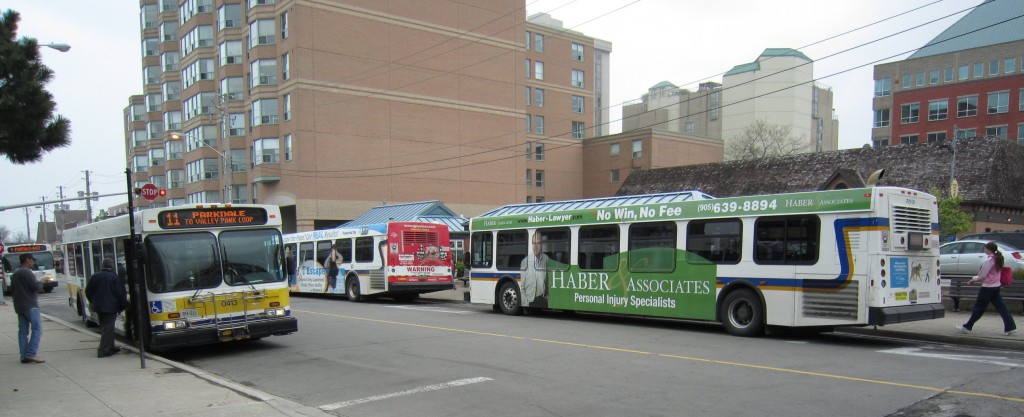
If there was ever a place to locate a transit terminal – that would be John Street where the only terminal in the city is now located. How will this terminal handle the planned increase in buses?
The 2024 target identified for Burlington represents a significant rate of growth over past performance and above what Burlington Transit’s peers have achieved over the past five years.
This will be difficult to achieve in a short period of time without significant investment in transit, a focus on customer service and culture change, including a change in how transit services are delivered.
As illustrated in Table 1, the ridership growth target will move Burlington Transit ahead of many of its peers and in line with peer systems that have U-Pass agreements with post-secondary institutions (e.g. Kingston Transit, Guelph Transit and St. Catharines Transit). This suggests that the growth strategy should not only focus on supply-based solutions (e.g. increasing service levels), but also on solutions that influence demand.
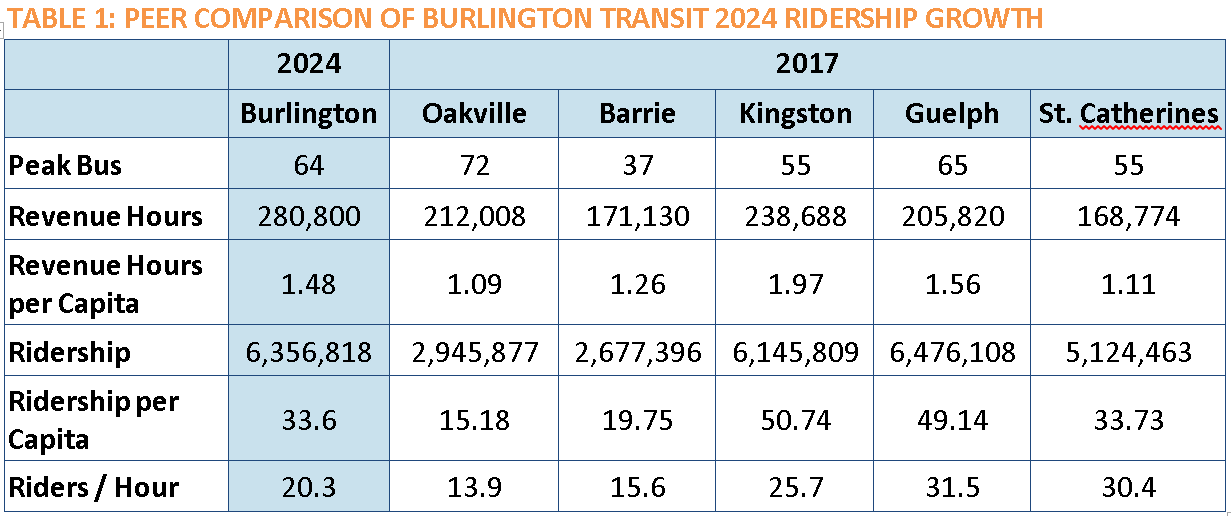
While population growth will also help grow ridership, Burlington’s population is only projected to grow by 3.7 percent by 20311.
Between 2019 and 2024, the population is projected to grow by 3,259 people (from 185,911 in 2019 to 189,170 in 2024). If the existing trip rate (boardings per capita) is applied to new residents over this period, this would only result in 56,255 new rides (1.8 percent of the ridership growth target) being attributed to new residents.
This means that to achieve this ridership target, existing and new residents will need to ride transit much more, creating a greater culture of transit use in the city.
Service Hour and Fleet Investment (2020 – 2024)
To accommodate the planned growth in ridership, Burlington will need to invest in the level of service provided to accommodate both an increased demand for service and to change travel behaviour. This will require an increase in the amount of service and the fleet required to deliver the service.
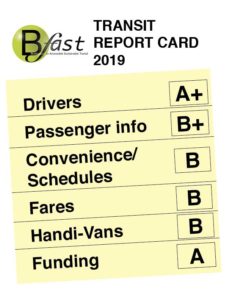
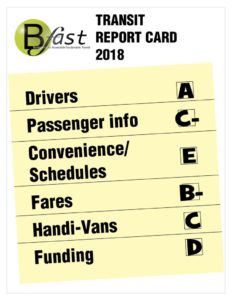 The City of Burlington Development Charges Transit Background Study (2019) identifies that Burlington Transit’s fleet will need to grow by 38 vehicles between 2019 and 2028 to meet transit mode share target. Phased in over the five-year life of this business plan, this represents a growth in 19 vehicles by 2024 (from 60 to 79).
The City of Burlington Development Charges Transit Background Study (2019) identifies that Burlington Transit’s fleet will need to grow by 38 vehicles between 2019 and 2028 to meet transit mode share target. Phased in over the five-year life of this business plan, this represents a growth in 19 vehicles by 2024 (from 60 to 79).
Service hours will also need to grow to reach the mode share target. Work by Burlington Transit to support the Development Charges Study estimated that an investment in 100,800 annual revenue service hours is required over the next five years. This represents a 56 percent growth in service levels, which is a little lower than the 66 percent ridership growth, recognizing that ridership growth can lag behind investment by two to three years. The projected fleet, service hour and utilization growth is detailed in Table 2. Ridership numbers were calculated based on achieving Burlington Transit’s 13.37 percent mode share target in 2031, based on the ridership figures used in the Development Charges Study. These targets were used as a guide to determine the growth strategy for transit.
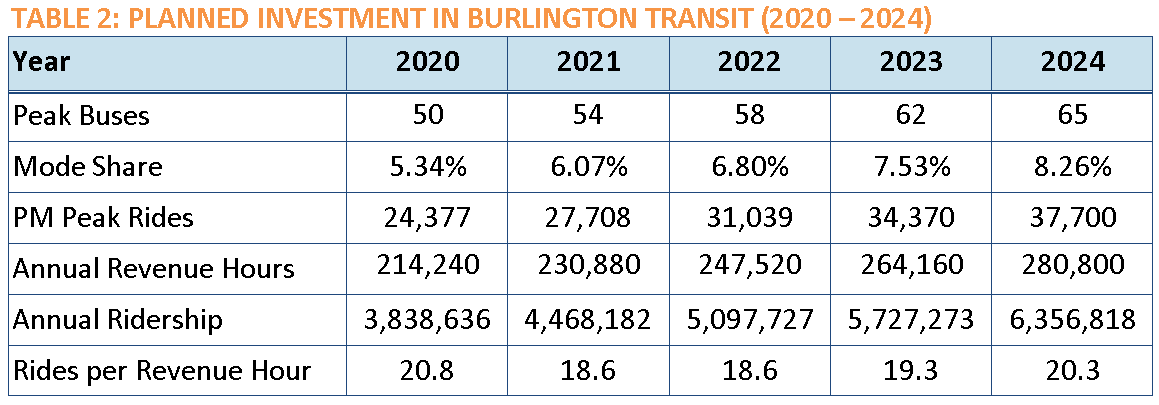
One of the primary purposes of a business plan is to focus actions taken by an organization so they are aligned with the vision, goals and strategies directions of a system. Burlington Transit has a mandate to significantly expand ridership in line with the mode share targets identified in the 2011 Halton Transportation Master Plan.
Forecast ridership is targeted to increase from 3,209,091 trips in 2019 to 6,356,818 trips by 2024. To achieve this growth target, Burlington Transit must provide mobility to residents, employees and visitors of the city. In doing so, Burlington Transit must:
• be Customer-Focused in every aspect of how service is delivered
• be Forward-Thinking in how services are planned and delivered
• be Business-Minded and aligned with municipal directions
This has become a litany for the people over at the transit offices where staff are pumped, engaged and know they have a leader who is going to move mountains if that’s what it takes to make transit work.
What a welcome change.


















Looking forward to the next six articles on transit.
Burlington Transit can not be looked at in isolation however, as the study needs to include the Hamilton and Oakville buses that link into the city, as well as the GO buses and GO trains.
Even the VIA train and the Airport limos run through town
By putting 38 more buses on the road will Burlington Transit replace UBER and LYFT ?